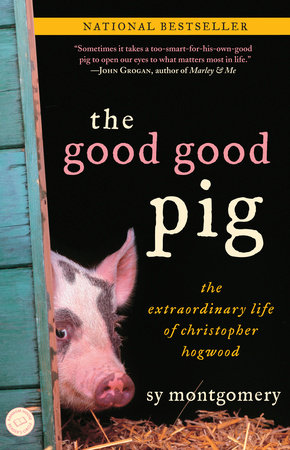The Good Good Pig Reader’s Guide
By Sy Montgomery


1. Did reading The Good Good Pig make you feel differently about your relationship to animals and the natural world? If you eat meat, for example, did it make you question that? Or question other aspects of your lifestyle?
2. Sy Montgomery writes about the extended interspecies family that coalesces around ‘the good good pig,’ Christopher Hogwood. If you have a pet or pets, do you think of the animal as a central part of your family unit, or as a kind of appendage to it? In what ways does your pet affect the family dynamic?
3. Lavishing as much money and attention on any animal as Sy Montgomery did on Christopher Hogwood is wasteful when there are human beings in need of assistance. Do you agree or disagree with this statement? Why?
4. Do you think you would have enjoyed having Christopher Hogwood and Sy Montgomery for neighbors? Why or why not?
5. We humans seem to have a love-hate view of pigs. On the one hand, there are beloved and humorous fictional characters like Miss Piggy, Piglet, Porky, Babe, and Wilbur. Yet at the same time, in many religions pigs are considered to be unclean animals, and in common parlance, calling someone a “pig” is far from a term of endearment. What do you think accounts for this divergence of views?
6. Do you feel a special connection to any particular kind of animal? If you could be an animal for one day, which would you choose and why?
7. At the beginning of the previous century, most Americans still lived and worked on farms and had close relationships with a variety of animals, both wild and domesticated. Now only a minority of people in this country experiences a close relationship with animals other than dogs, cats, and other familiar pets. What affect do you think that has had on our sense of connection to the natural world, both individually and as a society? Is it important to have that kind of a connection? Why?
8. Consider this quote from St. Francis: “Not to hurt our humble brethren is our first duty to them, but to stop there is not enough. We have a higher mission: to be of service to them whenever they require it.” What might this service consist of? If St. Francis were alive today, how do you think he would react to the animal testing of drugs and other products, livestock farming practices, and the like?
9. What are your thoughts about the animal rights and animal welfare movements? Are they following the advice of St. Francis or taking matters too far? What can people do to make a difference in the way animals–pets, livestock, and wild–are treated in our society?
10. Do animals possess inherent rights that human beings are morally obligated to respect? If so, what is the source of these rights? Should animals have legal or civil rights beyond what is currently accorded them?
11. Do animals have souls?
12. Is the hunting and killing of wild animals an important part of human heritage that should be preserved?
13. The people of Sundarbans regard the local tiger population as manifestations of the divine, and thus do not hunt the animals even when they prey upon human beings. Montgomery finds much to admire in this attitude. Do you agree with her? Why or why not?
14. There are many anecdotes reflecting the extraordinary, even uncanny, sensitivity of animals toward the natural world and toward people. What examples can you give from your own experience, and how do you explain them?
Just for joining you’ll get personalized recommendations on your dashboard daily and features only for members.
Find Out More Join Now Sign In